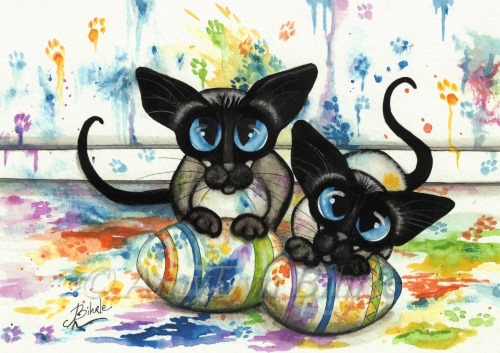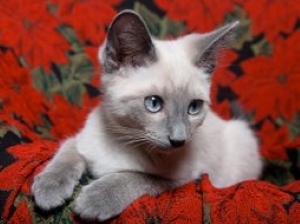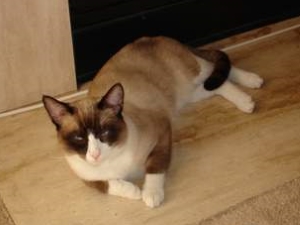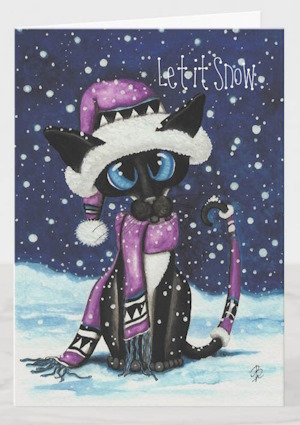- Home
- Meezer Musings
- March 2021
Meezer Musings: March 2021
That Cold Clear Gaze of Ancient Skies
Welcome to the March issue of Meezer Musings! As we pass through the first anniversaries of the appearance of Covid-19 in our respective countries, I
hope you and your human and fur-families are safe and well wherever you might
be in the world. My thoughts go out to everyone who has been affected
in any way by the virus.
In February I mentioned the poem 'To Lob', that includes the line 'that cold clear gaze of ancient skies', referring to the blue of a Siamese cat's eyes. And this month we're talking all about eyes, and what it is that makes a Siamese cat's eyes blue, and the shape of the Siamese eye, and about eye health.
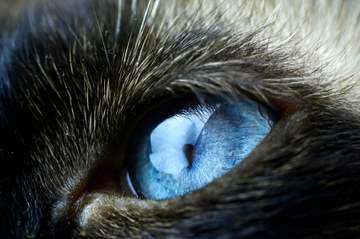 "That cold clear gaze ... "
"That cold clear gaze ... "Image © iStockphoto | Oonal
A Question From Our Postbag: Seasonal Shedding
But first we're going to take a look at a question sent in by email about seasonal fur shedding. A few weeks ago I received the following from one of our readers, Larry.
"We have a 4-year-old seal point female Siamese cat. She seems to be shedding more than normal for the past few weeks. Do Siamese cats have seasonal shedding? Are there certain times of the year that they shed more than others?"
The short answer to this is, yes! Cats shed their winter coats in the spring as the days get longer and warmer and conversely, in the autumn, their coats build up again against the
winter cold.
Bandit used to shed copiously in the spring and it obviously made his coat rather itchy - we'd find little clumps of fur all over the house! If you are noticing this as we (in the northern hemisphere) move towards the summer you're not alone. There's no need to be alarmed unless
your cat is showing any signs of illness.
We'll learn a little more about Larry's seal point girl later on, but first, let's turn back to eyes.
Blue, Blue
As all of us know, a Siamese cat's eyes are blue. They're variously described, in guides for show judges, as "clear, brilliant, deep blue"; "clear bright vivid blue"; or "brilliant intense blue" depending on point color.
In the everyday world outside the show arena, eye color can vary from pale ice blue through light aquamarine, bright turquoise, cornflower and royal blue and every shade in between all the way to deep sapphire and violet.
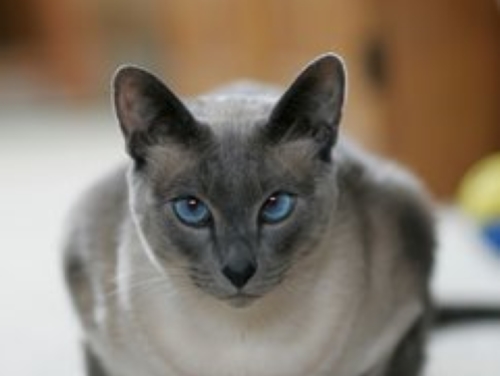 The sky-blue eyes of a blue point
The sky-blue eyes of a blue pointImage © iStockphoto | Steven Miric
These blue eyes are caused by the same genes that create the Siamese pointed coat pattern. Most cats have genes that create green, yellow, or copper-colored eyes according to the amount of melanin (pigment) produced in the eye, but the Siamese gene has the effect of decreasing the amount of melanin produced - so the blue eye color comes about because of decreased pigmentation.
Without getting too technical, what you are seeing in a blue eye is blue light refracting off very tiny pigment particles, and not actual blue pigment.
Sticky Eyes
Our focus on eyes this month came about through a question from one of our Facebook visitors, Vicky, who asked:
"Does anybody else’s Siamese suffer with runny eyes? He’s a chocolate point, 9 years old. I was wondering if this was common for the breed?"
This is shown in Vicky's photo, below.
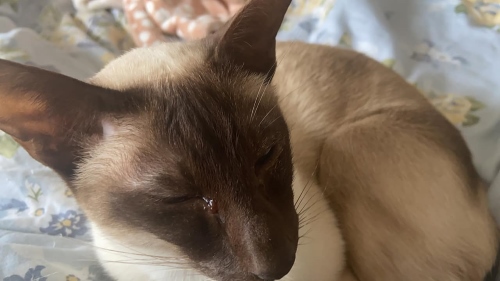 Photo with thanks to and copyright © Vicky Rtrt
Photo with thanks to and copyright © Vicky RtrtRunny eyes do seem to be quite common in Siamese cats, and in part this has to do with the shape of their eyes, as the diagonally-slanting almond shape forms a channel down which secretions can run into the bottom corner of the eye.
If the secretions are clear and occur with no other symptoms they're usually nothing to worry about - this could happen as a result of dust, or pollen allergies, or something similar.
If, however, the secretions are pus-like, and occur along with other symptoms like reddened, swollen or inflamed eyes, or the haws (third eyelids - see below) are clearly visible and cover more of the eye than is normal for your cat, then it's an indication of something more serious, and time to head for the vet for a check-up.
Sticky eyes, especially when accompanied by sneezing or a runny nose, may be an indication of feline herpes, a very common infection in cats. This is usually self-limiting - that is, it will usually disappear of its own accord within a week or two, but again, if your cat appears to be in any discomfort or pain or if the condition is recurring, have it checked out by a vet.
Vicky's question struck a chord with others who had been wondering the same thing; if you're on Facebook you can see the question and replies here.
You Should Always Consult a Veterinarian ...
If you see any of the following:
- Redness
- Cloudiness
- Abnormal discharges
- Obvious difficulty with vision
- Pawing at the eyes
- Raised 'third eyelids' (see below)
Third Eyelids, Haws, and Nictitating Membranes
Say what?! You may be wondering about the words above but they all mean the same thing. Cats (and some other species including camels, polar bears, seals, and, curiously, aardvarks!) have a 'third eyelid' located under the two outer eyelids, in the inner corner of the eyes.
The purpose of this third eyelid is to protect and moisten the eye by blinking (nictitate comes from nictare which means 'to blink' in Latin) while still maintaining vision. But unlike the top and bottom eyelid, which blink vertically, the third eyelid blinks horizontally.
The third eyelid is a transparent membrane and is not usually very noticeable, however if it becomes infected or if there's a change in a cat's health these membranes may be inflamed or cloudy and may cover more of the eyes than usual.
This is a condition known as Haws Syndrome (the third eyelid is known as a haw in horses, although in cats it's more generally known as a nictitating membrane), and, once again, it's off to the vet.
Sometimes this inflammation can be caused by a digestive upset, sometimes by a mild virus common in cats called Torovirus, but sometimes protruding third eyelids can be a sign of something more serious, so they shouldn't be ignored.
However ... because of the shape of their eyes, in some Siamese cats the third eyelid may be permanently more prominent than in other cats - which is why I said above 'whatever is normal for your cat'. Between you and the vet, you can decide what is 'normal for your cat'.
Nystagmus
Another eye condition that's worth mentioning because it also seems to be quite common in Siamese cats, is one called nystagmus.
Nystagmus (which can also occur in humans) is a neurological condition that causes uncontrollable eye movements in which the eyes appear to be shaking - either up and down or from side to side, as you can see in the YouTube video of this blue point Siamese, below.
(Before watching this, turn your sound down - there's a jolting blast of music at the end!)
There's no cure for nystagmus and it doesn't affect a cat's health so is usually nothing to worry about, but if it's accompanied by head shaking or tilting there may be some other nerve problem involved. As always, a vet's opinion should be sought if you have any concerns at all.
Meezer of the Month
We haven't had a Meezer of the Month for a while. For March, we welcome four-year-old seal point Samantha, the subject of the coat-shedding question above. Her 'people' used to be dog owners but they've had to become used to being bossed around by a Siamese cat!
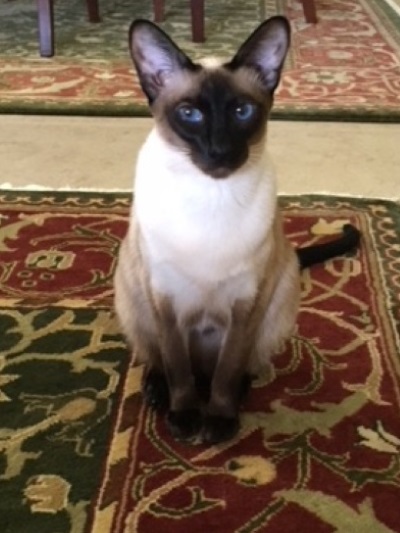 Samantha, who very much has that 'Siamese gaze'!
Samantha, who very much has that 'Siamese gaze'!Photo with thanks to and copyright © Larry Starr
Here's what Samantha's 'owner', Larry, has to say:
"She allows us to live in the same house as her. She has a meow vocabulary for every occasion, which we, her subjects have learned to decipher, and shamefully obey.
She loves to be around people and must inspect every person or package that enters her kingdom. We are former dog people who are used to giving our canines orders; quite a switch to now catering to every whim and mood of Samantha.
Thousands of years ago Siamese cats were worshipped as gods, and Samantha has never forgotten this."
Samantha sounds like a true Siamese character and ambassador for the breed! Thank you, Larry, for sharing her with us.
Tail End ...
As we head towards April, Easter is coming up next weekend so for those who celebrate it, I hope you have a very happy Easter. To mark it here's one of AmyLyn Bihrle's beautiful Siamese cat art pieces (complete with trademark huge, blue, Siamese cat eyes) of two naughty kitties painting their Easter eggs - and everything else around them!
Prints of this very cute painting are available from AmyLyn Bihrle on Etsy.
Another date for your diary is April 6th - National Siamese Cat Day. A day of celebration for all Siamese cats and particularly those in the United States.
I always feel it should be International Siamese Cat Day! But wherever you are in the world, mark the day in your calendar and give your kitties a few extra cuddles and treats ...
Caroline
Missed a Meezer Musings? A list of previous newsletters can be found here.
Some of the articles and newsletters on this site may contain links to products I think you may enjoy. If
you purchase through these links I receive a small commission, but there's
no extra cost to you. Find out more on the Affiliates Disclosure page.
Have You Discovered Our Newsletter?
If not, why not? Subscribe to our email newsletter, Meezer Musings, to stay in touch, be the first to see new information and pages as they come out, and read the things we only talk about in the newsletter.
Learn more about it on our Newsletter Sign-Up page.
